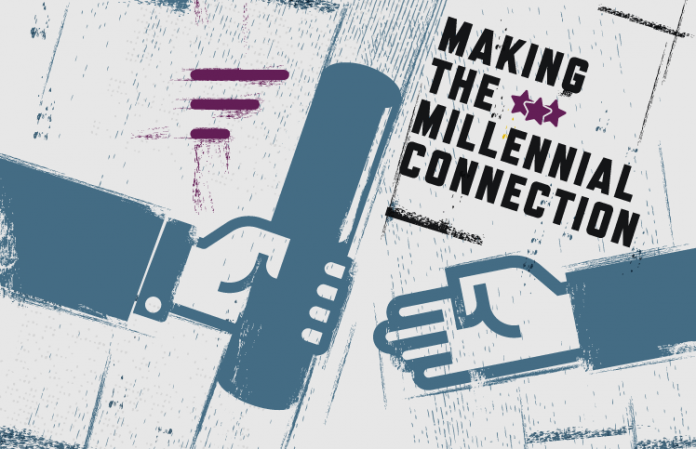
I think it’s safe to say that millennials are a force to be reckoned with. Often referred to as “Generation Disruption,” their influence on the modern workplace is hard to deny. In recent years, millennials’ expectations have been reshaping the workplace into more flexible, collaborative and transparent environments.
These types of changes will only become more impactful as the number of millennial workers increases. According to the Brookings Institution, millennials will comprise one-half of the workforce by 2020 and 75% by 2025. Yet, many employers are still not prepared to meet their millennial workers’ demands.
Businesses that adhere to hierarchical organizational structures, in particular, will find it increasingly difficult to hold onto their employees in the coming years. Simply offering perks like food and fun activities (longtime call center motivation methods) has been found to be ineffective at building loyalty and commitment. In fact, a recent ReportLinker study found that only 40% of millennials feel highly committed to their organizations.
Admittedly, creative workplace perks are nice to have—after all, who wouldn’t like to relieve tension with a midday onsite massage or challenge a co-worker to a game of ping-pong while on break? But overall, millennials tend to gravitate to those companies that offer help with balancing their work and personal lives. Study participants said that, of all the perks offered to them, they’re more likely to use healthcare (54%), flexible working hours (41%), paid family sick leave (33%) and career development services (23%). Also, while just 11% said that their employers offered telecommuting, 22% ranked it as No. 1 among perks that they considered to be essential.
What’s more, the survey found that the top three drivers of commitment to employers didn’t involve perks at all. Millennials desire opportunities to:
- Be involved in decision-making (87%),
- Take on new professional challenges (83%), and
- Be innovative and creative (78%).
Some centers have already recognized that the rules of engagement have changed, and have put in place practices that align with their staff’s expectations. Take, for instance, Valvoline’s strong focus on employee development and collaborative efforts to continuously improve the work environment. In an industry where a 30% turnover rate is typical, Valvoline’s support center boasts an impressive average agent tenure of 10-plus years. You can read more about their story in the September 2017 Inside View column.
A Model for Managing Millennials
Millennials’ expectations in the workplace have been shaped by numerous things in their upbringing—including helicopter parents, constant positive feedback and profound technological advances, among others.
“Millennial workers grew up in a more transformational than transactional environment,” says Dr. Jesse Calloway, leadership consultant, trainer and author of All the Way to the Top: A Practical Guide for Corporate and Business Leadership. “Millennials more accustomed to contingent reward. For instance, when I was coming up in the corporate world, I was rewarded for standalone or individual accomplishment. It was about me and what I did. If I solved problems, I was rewarded; If I didn’t, I wasn’t rewarded. That is the transactional view. In contrast, millennials have been nurtured in a more transformational manner. They received more feedback and coaching.”

Calloway points to the No Child Left Behind Act of 2001, which held teachers accountable for ensuring that their students and schools passed standardized tests. As a result, teachers significantly increased the amount of feedback and engagement with students.
“Now that those former students are in the workplace, they bring with them a certain expectation that is consistent with transformational leadership,” he adds.
How can you apply a transformational leadership technique in your contact center? Calloway has developed a model that he calls “the 5 Cs.” They include:
Conversation. The first step is to have a conversation with each agent to provide feedback about his or her performance improvement opportunities. It’s important to offer “personalized feedback and consideration—the same type of individual interaction that they grew up with,” he says.
Calculation. During the calculation stage, look for ways to engage agents intellectually. Provide them with personalized goals that the individual can achieve and discuss how to work toward them (e.g., “Bob, I need you to improve your cSat rating by 5%. How should we approach this?”).
Collaboration. “Very little gets done without collaboration,” Calloway states. Emphasize that you’re working together to reach the goals that you set with your agent in the calculation stage. For instance: “Bob, I need you to help me identify the obstacles that are preventing us from achieving a 5% increase in cSat.” Then follow up with: “Let’s have a conversation about how we can remove them.”
Communication. Continuous communication is critical to ensure that agents are moving toward their goals. Provide ongoing feedback about their progress and work together to overcome any barriers that surface.
Cognizance. “What gets measured, gets done,” Calloway notes. “Sharing the vision, goals and objectives with your agent is just the beginning. You also have to provide them with a means to measure their progress on a real-time basis.”



